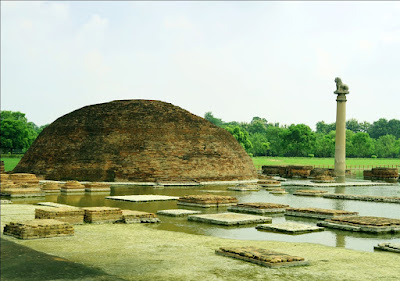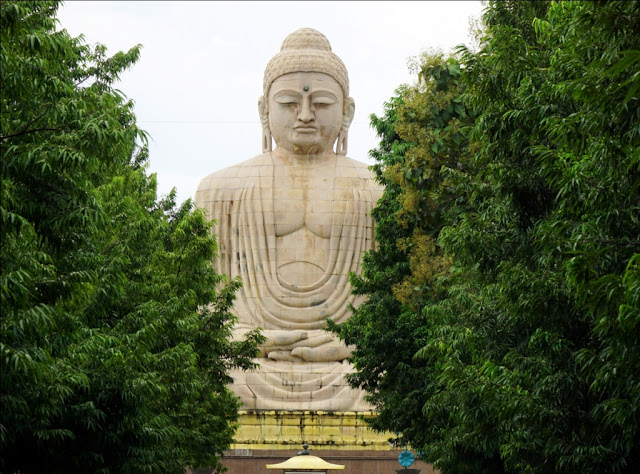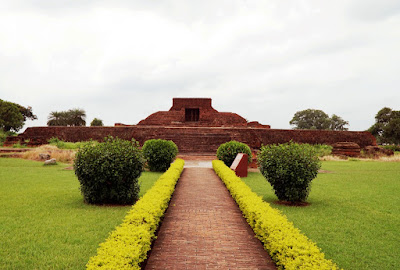 |
| The Gole Ghar, Patna |
Bihar – the cradle of Indian civilization
[Bihar
is a rich state with some of the poorest people living in it. It is rich in
fertile land, plenty of water, and hardworking people. This is the state which
each year lands more IAS and IIT seats. Also this is the state where ugly caste
politics has dragged its people down into poverty.]
A visit to the state of Bihar has been on my bucket list for
quite some time. Earlier in Feb 2020 I made a short trip to Kaimur district of
Bihar hoping to take another journey soon. Then corona struck and all my travel
plans went haywire.
 |
| Nalanda - the ruined university |
Exactly a year after, I mustered courage and embarked upon my
journey, this time to the western state of Gujarat followed by a trip to the
North East in March. Then came the second wave and once again we were confined
to our homes. However, with the second corona wave came the vaccination drive
too.
After taking two jabs and emboldened by the ebbing wave I
decided to slip into my trekking shoes once again with Bihar uppermost on my
mind.
It was August 2021 and the erratic monsoon was wreaking havoc in
the eastern parts of India including the area of Bihar that I had planned to
do. Watching the weather forecasts and vagaries of monsoon became a full time
job. Anyways, I had to bite the bullet and finally took a calculated risk by
booking my tickets for a journey starting 05 Sept 2021.
Enthusiastically, I made an eight day travel plan and set out to
cover the following places in Bihar:
 |
| The Mahabodhi temple and tree, Bodhgaya |
-
Patna
-
Vaishali
-
Chirand
-
Gaya
/ Bodhgaya
-
Rajgir
/ Nalanda
-
Barabar
& Nagarjuni caves in Jehanabad
VAISHALI
They say the first republic in India was established in the 6th
century BCE here by King Vishal. There are some ruins in Vaishali which they
say are those of a fort/palace belonging to the King. I, however, would take
it with a pinch of salt.
Vaishali is the birthplace of the last Tirthankara of Jainism –
Lord Vardhaman Mahavira. Lord Buddha is said to have attained nirvana here
after giving his last sermon. Here the
second Buddhist council after the Buddha’s demise was also held where the
Ananda Stupa and the Asokan pillar stand today. And then, Ambapali / Amrapali –
the legendry beautiful courtesan also lived in Vaishali.
 |
| The Ananda Stupa & Asokan Pillar, Vaishali |
CHIRAND
I wanted to see this place where the ASI excavations have resulted
in finding stone tools of Neolithic period (7 to 8 thousand years back). The
tools are uniquely made and polished. Chirand is a village situated on the
north bank of river Son. It is located near the boat starting point in Doriganj
– a place notorious for illegal sand extraction by the sand mafia of Bihar.
Unfortunately, it was Monday and the museum was closed.
 |
| Inscription in one of the caves |
I decided to know from the locals about the sand trade and was told that the sand mining rights were leased out for 99 years by an erstwhile chief minister of Bihar to one of his relatives. There are hundreds of interstate trucks filled with illegal sand and impounded by the authorities. It is a chaotic situation there in the area.
Three days before my arrival in Patna there were heavy rains.
Vaishali was inundated and so were the surrounding area and the roads. We had
to take a longer route to reach Vaishali from Patna as the usual route via
Lalgunj was under floodwaters. The water wasn’t receding as the river Sone in
spate had breached the earthen bunds thereby letting more water into the low
lying plains.
After doing Vaishali and Chirand from Patna, I made Bodhgaya my
base for the rest of my travels in the area. I chose Bodhgaya over Gaya because
the latter is much polluted, crowded, and unclean. Comparatively, Bodhgaya is
calm, cleaner, and wide open. It is not cost effective to make Bodhgaya as a
travel base but the serene and calm atmosphere would compensate.
Due to the pandemic, Bodhgaya is not fully open. Only the
Mahabodhi temple and the 80 feet Buddha are open to the tourists.
 |
| The 80 feet Buddha statue in Bodhgaya |
Rajgir & Nalanda
It requires one full day to do these destinations. Nalanda is 75
km from Gaya and Rajgir 10 km short of that. It was overcast and instinctively
I decided to visit Nalanda first and asked the driver to move straight without
stopping at Rajgir.
Nalanda was a prestigious centre of learning in ancient India.
Founded in CE 427 by a benevolent and erudite king named Kumaragupta I, the
university continued to spread knowledge and wisdom across the globe for the next more than 7
centuries. Then came a savage marauder named Mohamed Bakhtiar Khilji who in the
name of Islam, massacred the monks and teachers and plundered Nalanda in CE
1193. He put the library on fire and the 9 million manuscripts continued
smouldering for 3 months. That was the end of Nalanda.
Two hours were enough for me to cover the Nalanda ruins.
Rajgir
Rajgir is the place in Magadha of Mahabharata lore where the mighty
Jarasandh ruled. He was killed by Pandava son Bhima in a physical bout of
wrestling.
 |
| The Swarna Cave, Rajgir |
Swarn Bhandar caves
When we reached back Rajgir, the rain had already stopped and my
journey went on uninterrupted. I started with the Swarna Bhandar caves. These
two man made caves are claimed by both the Buddhists and the Jains. The name
swarn bhandar or Sona bhandar is misleading. The caves are not related to any
gold stash /deposits though the legend has it that there is a secret door in
the rock which can be opened by an inscription engraved there. The guide told
me that the inscription hasn’t been deciphered yet. More of myth than anything
close to reality.
About 15 km from Rajgir, in the thick forest, Bihar Forest
department has erected an 85 feet glass bridge. This is not actually a bridge
as it doesn’t span and gorge/waterbody. It can at best be termed as a glass
platform to give you a feeling of a skywalk as you look down through the glass
floor. Not much to write home about. You waste a lot of time and gain nothing
by going there.
The Ajatshatru Fort
There’s a trace of boundary wall in a small piece of land. A man
sits in the corner. He is a self styled tourist guide. “Come, I will show you
the jail where king Ajatshatru had imprisoned his father Bindusar”, said the
man to me. “But Sir, there is nothing to see here. No ruins are visible, How
and what you will show me”, I retorted back. Then he explained that everything
was underground and he was ready to explain the whole thing to me. But I wanted
to see, not hear another story. That was it. The worst thing to happen to a
traveler anywhere in the world is when you are asked to listen to a mythical
narration in the name of showing an ancient monument.
The world peace Pagoda

Then there are mythical places like the arena where they say the
wrestling bout between Jarasandh and Bhima continued for 18 days, and also the
track marks of the wheels of Lord Krishna’s Chariot. Hinduism has too much of
such mythical lore. The less said the better.
Barabar & Nagarjuni
caves
 |
| Lomas Rishi cave, Barabar |
 |
| Inside Lomas Rishi cave |
Some 40 km from Bodhgaya towards Jehanabad, we find 7 caves cut
into granite rock. Four of these are in Barabar hill and three in Nagarjuni
hill. They also call this group of 7 caves as Satghar or seven homes. These simple
rock cut caves are considered to be the oldest in India belonging to the 4th
century BCE. They are said to have been cut between 322 – 185 BCE. The Sudama
cave is said to be the oldest. Comparatively, the oldest of Ajanta caves in Maharashtra,
India belongs to the 2nd century BCE though they continue to be made until
the 5th century CE.
Three of the four Barabar caves are on a single rock and the
fourth – Vishwakarma cave, one is a little distance away. The three are Karana
Chaupar, Sudama cave, and the Lomas Rishi cave. The granite rock looks like a
whale from one side (where the Karan cave is) and a crocodile from the other
(where the Sudama and Lomas caves are). All these caves are rock cut and so
finely polished that one’s reflection is visible like in a mirror, though not
that sharp and clear.
 |
| The Vapiyaka cave, Nagarjuni |
Some two km away on the Nagarjuni hill are 3 more such caves.
These are Gopica cave, Vedathica cave, and Vapiyaka cave. The Gopica cave is
visible when you park your vehicle by the building of the South Bihar Power
Distribution company. It is about a 500 m walk to the point where the steps
start. Walk up 55 steps to reach the big cave. The other two caves are at a
distance of about one km from this cave.
 |
| The Gopica cave, Nagarjuni. Biggest of the seven |
The track is not well laid out and chances are that you get lost
like I was. I went about 2 km in the wrong direction when I sensed that the area
I was in had no chance of a rock cut cave in existence. I returned back and
found a farmer tending his cattle. This man Kishori Paswan was nice enough to
take me to the remaining two caves; Vedathika and Vapiyaka. But for his
guidance, I wouldn’t have reached the last two caves. Those two are deep inside
the forest area.
King Ashoka is said to have given these caves to the ascetics of
the Ajivika sect who were ardent atheists of that era.
My week long trip went smoothly without any disruption from the
rains. All I lost to the rains was about 30 minutes of my time while visiting
the Sky Walk safari in Rajgir.
PS:
As I write this piece, I hear that Chirand village is seriously
under floodwater and also, other areas of Vaishali are inundated due to heavy
rains in the past few days.
 |
| Shining interiors of the Vapiyaka cave, Nagarjuni hill. Granite polished surface. |
 |
| Karna Chaupar, Barabar hill |
 |
| Sudama cave - the oldest one |











�������������� Elle
ReplyDeleteTop blog! Elle
ReplyDeleteThanks, Elle. keep visiting
DeleteBeautiful pictures , very informative and engaging blog .
ReplyDeleteThanks, Rashmi. Hope you enjoyed.
DeleteGreat blog! Educative too.
ReplyDeleteThanks, Jayanti. Keep visiting.
DeleteGreat blog!Very impressive
ReplyDeleteThanks Fenny. Keep visiting.
Delete